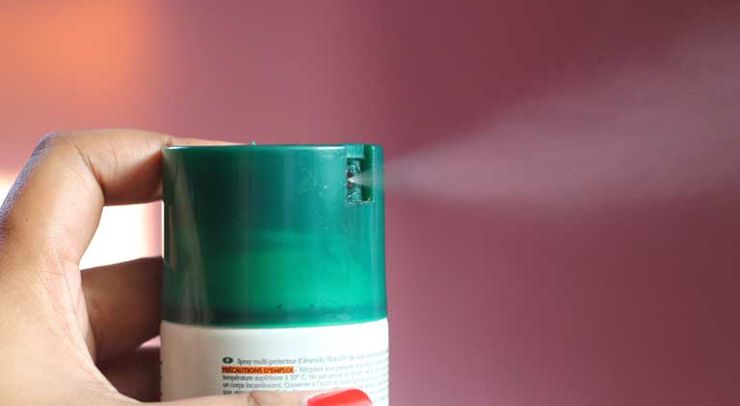Plastic antibodies to fight BO

If antibodies, as is the case, can recognize pathogenic agents, should we not be inspired to draw on this and assemble synthetic equivalents, in the form of polymer molecular moulds to target the molecules incriminated? The so-called MIPs (acronym for molecularly imprinted polymers) have been made to trap the molecules in question, viz., those involved in producing “BO” polite [and politically correct] acronym for ‘body odours’). Following an initial success in the area of cosmetics1, it would appear that MIPs also have a promising future in biomedical practice where improved medicinal targeting has become necessary.
Let us imagine we no longer need to ‘plaster’ our armpits with deodorants which do not respect our skin and its ecosystem and that we choose instead to trap the molecules specifically responsible for development of unwelcome ‘BO’? This has been made possible through the research work by Karsten Haupt, Professor in nanobiotechnologies and Head of the UTC-GEC (Enzyme and Cell Engineering) Lab. with Bernadette Tse Sum Bui, research engineer at the CNRS, in the framework of a MIP research partnership with L’Oréal. Drawing on the faculty of antibodies to recognize certain molecules, their research teams developed some synthetic materials capable of capturing the molecules in our body transpiration (sweat) involved in creating BO.2
The art of molecular imprinting
In essence, these MIPs are bio-inspired and bio-mimic materials that resemble minute plastic particles less than 1 micron in size. They contain small cavities the shape and chemical characteristics of which correspond exactly to those of the targeted molecules. They are obtained via a process called molecular imprinting, which consists of moulding the polymer round a single target molecule that serves as a molecular template. “UTC-GEC has the equipment to make the moulds and produce the MIPs”, underlines Karsten Haupt who adds that “if the process itself is not new, this is the first application in the cosmetics field”.
Trapping offensive smells
The research programme in the partnership with L’Oréal consists of designing and producing MIPs that are specialized to capture certain “precursor” molecules present in our body transpiration and responsible for the production of ‘BO’. These non-odorous molecules are fed on by bacteria present in the skin – they consume the molecules and then degrade, producing volatile organic acids that do smell. Capturing the molecules upstream is an especially elegant process since it does not destroy the bacteria as do currently commercialized deodorants. They therefore do not disturb the skin’s ecosystem and do not favour development of micro-organism resistance factors. The MIPs only have a low impact on the bacteria, simply reducing and limiting their natural food supply.
“The MIPs we have produced in this L’Oréal partnership work target one out of three groups of molecules responsible for unpleasant smelling skins”, underscores Karsten Haupt, leaving the door open to design specific MIPs for each group. A patent3 claim has been registered by UTC-GEC for these MIPs, and it is now up to L’Oréal to integrate the products for the first consumer uses in cosmetics.
Separate, capture or deliver substances
MIPs have been used since the 1980s in the chemical industrial sector to ‘recognize’ and separate various forms of a given molecule, or various different molecules with similar structures. They are produced today by several companies for use in analytical work in the biomedical and agro food sectors. Numerous applications existent in environment-intensive applications to detect and capture undesired molecules, or in the safety sector. UTC-GEC for example is engaged in a European project to design and assemble tools to detect artisan explosives and drugs. However the main area for applications is the biomedical sector with possible outlets in medical imaging, such as the use of fluorescent antibodies to detect cancerous tumours. In this case, the MIPs are designed on the model of those antibodies capable of targeting chemical structure that are specific to tumorous cells.
In reverse, MIPs can be “loaded” with active substances that can be delivered to various organs, for example to the skin surface. Such processes are being envisaged for certain treatments that call for very precise, accurately targeting to avoid side effects.
Bioresources, Bioinspiration and Biomimetics
One of the reasons for the ‘popularity’ of MIPs lies in the ease with which they can be manipulated and stored (better and easier than antibodies). They are less sensitive to temperature and more stable, chemically speaking and thus better adapted for use in “extreme” environments. They also can be produced at lesser costs, and they do not require laboratory animals as is the case for production of antibodies. As Karsten Haupt sees it “there seems to be a high attached potential to our research and numerous application areas for the products”. UTC-GEC will now focus on their possible utilizations as active agents in the biomedical field, based on this innovative application of MIPs in cosmetics. The UTC-GEC Lab is committed to several national and European research propjets in “bioresources, bioinspiration and biomimetics” and the Lab wishes to invest more to these aspects in the coming research programmes. The concept of using an MIP as an active agent offers scientists an opportunity to closely study Nature’s mechanisms and processes so as to be able to mimic them and design new materials and tools.
[1] www.rsc.org/chemistryworld/2016/05/plastic-antibodies-molecularly-imprinted-polymer-deodorant-fight-body-odour; www.cosmeticsdesign-europe.com/Formulation-Science/L‑Oreal-backs-research-into-plastic-antibodies-in-deodorant
[2] S. Nestora, F. Merlier, S. Beyazit, E. Prost, L. Duma, B. Baril, A. Greaves, K. Haupt, B. Tse Sum Bui, Plastic antibodies for cosmetics: Molecularly imprinted polymers scavenge precursors of malodors. Angewandte Chemie International Edition, 2016, 55, 6252–6256.
[3] A. Greaves, F. Manfre, K. Haupt, B. Tse Sum Bui, WO 2014/102077 A1, 2014.
Plastic antibodies for cosmetics: Molecularly imprinted polymers scavenge precursors of malodors.
S. Nestora, F. Merlier, S. Beyazit, E. Prost, L. Duma, B. Baril, A. Greaves, K. Haupt, B. Tse Sum Bui. Angewandte Chemie International Edition, 2016, 55, 6252–6256.
A. Greaves, F. Manfre, K. Haupt, B. Tse Sum Bui, Brevet L’OREAL WO 2014/102077 A1, 2014




